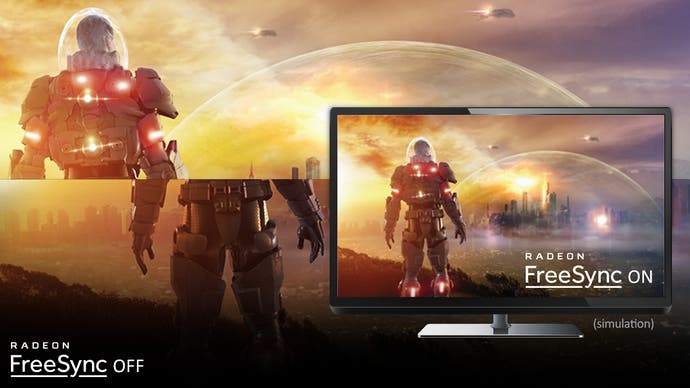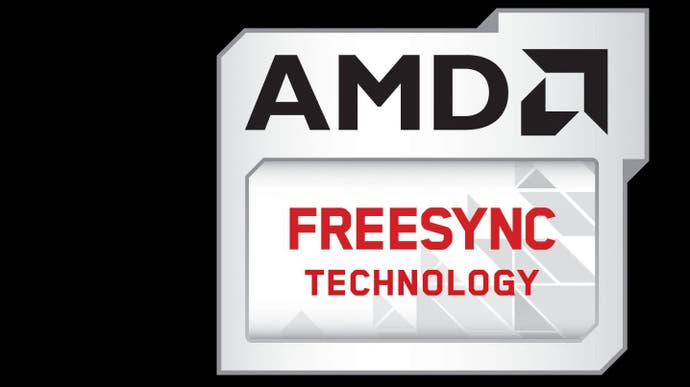FreeSync display support tested on Xbox One X
Smoother, faster, better?
It's potentially a revolution in the console space - just as it has been for PC gamers. Variable refresh technology is a big win for improving the game experience, lessening judder and removing screen-tearing. It's a pretty simple concept really, levelling out performance by putting the GPU in charge of when the display should present a new frame. It's a game-changer. No longer are unlocked frame-rates a problem - in fact, 40-50fps gameplay can look almost as smooth as 60fps. It's a remarkable trick, but crucially, it works. Nvidia's G-Sync led the way, but it's AMD's alternative - FreeSync - that has been built into Xbox One, and we've finally had the chance to test the technology. Clearly it's still early days, but at its best, the results are quite remarkable.
Let's begin by laying out the basics. Microsoft's variable refresh implementation only works with FreeSync screens - G-Sync monitors are incompatible - but the Xbox version of the tech is bespoke, with some pretty big differences compared to AMD's rendition. There's strong compatibility though: you'll need a display that supports FreeSync over HDMI (as opposed to the more common DisplayPort) but on the Microsoft end at least, there's support for 720p, 1080p, 1440p and 4K outputs. We've had confirmation that both Xbox One S and Xbox One X are invited to the party, but the firm also told us that older launch model hardware also gets the upgrade.
Choosing a FreeSync display isn't as easy as you might think. Our testing was conducted using an Asus VP28U - a native 4K screen that support FreeSync over HDMI, but we found that it only supported variable refresh at 1080p resolution, meaning we needed to set our Xbox One X accordingly. So in searching out a 4K screen for an X owner, FreeSync over HDMI 2.0 is a must. Secondly, there's the concept of the FreeSync 'window', or the 'range' as it's described on the AMD list of supported displays. This is the range of frequencies in which FreeSync is actually active. On the VP28U, this is defined as 40-60Hz (very common for 4K screens) but the wider it is, the better the FreeSync experience. The problem here is that the wider ranges only tend to be associated with lower resolution, non-4K screens - potentially making the FreeSync tech a better match for the 1080p-orientated Xbox One S.
So why choose the Asus VP28U? It's hardly at the high-end when it comes to FreeSync-supported monitors, but Microsoft tells us that it uses an Asus monitor for testing owing to its 'Game Tools' FPS counter (other display manufacturers may also implement this feature). It can't measure game frame-rate accurately but it can keep track of the display refresh rate, which is tied closely to game performance when FreeSync is active. This is actually a hugely valuable tool in figuring out how variable refresh is implemented on the Xbox platform, because it turns out that it's very, very different from its AMD PC counterpart. It's very much work-in-progress right now, results can be variable, but when it does work, you're in for a treat.
We tested a number of titles and two in particular produced stand-out results. id software's Wolfenstein 2 on Xbox One X is a spectacular case in point. At launch, we weren't too happy about a frame-rate that sat within a 40-60fps window - a state of affairs that saw the developers add an extra-aggressive form of dynamic scaling to smooth out the experience via a later patch. FreeSync removes the v-sync judder of the standard dynamic res mode, making for a mostly smooth, consistent experience, but the big surprise for us was how well turning the scaling off completely and running at fully native 4K turns out. The majority of gameplay sits within the monitor's 40-60Hz FreeSync window and while there is some judder in heavy combat, the experience is mostly very smooth indeed - almost as good as running locked at 60fps. The fluidity of the game is fully at odds with the 40-50fps fluctuating on the frame-rate counter, but there it is - it looks excellent. If you're looking for a signature game for showing off what variable refresh can do for Xbox One, this is the title for you.
Almost as impressive is The Vanishing of Ethan Carter, where again, its native 4K mode (when combined with turning off the frame-rate cap) works beautifully with FreeSync. Left-right panning of the viewport easily highlights judder with the mode disabled, but Ethan Carter holds up under FreeSync, looking really smooth, even as frame-rate once again darts between 40-50fps. However, moving into denser scenes can see the game move out of the FreeSync window, dipping beneath 40fps. At this point, the Asus FPS monitor incorrectly notes a jump to 60fps and it's accompanied by obvious on-screen stutter. By and large though, it's another good title for showing off what FreeSync can do. It can also be used with the game's 1440p mode, where frame-rate is closer to 60fps, and where you should comfortably remain in the FreeSync range for butter-smooth gameplay.
Beyond those two titles, we ended up hitting several limitations and issues. Take F1 2017, for example. It's a game that looks great, but is impacted by some highly intrusive screen-tearing, lurking in the 50-60fps area. In theory, it's a great test for Xbox One's FreeSync functionality, but we quickly discovered that in its current state, the feature only works on Xbox One games that enforce v-sync. If a game has tearing on a standard display, it'll have tearing on a FreeSync screen too. We spoke to Microsoft about this, and while the engineers are looking into F1 in particular, the firm says that adaptive sync tearing in the 30-40fps range can produce a smoother experience than attempting to run FreeSync instead on our 40-60Hz display.

However, in both Rise of the Tomb Raider and Final Fantasy 15 performance modes, the judder looked little better than running on a standard screen and we can't help but feel a little disappointed. Those hoping for FreeSync as the cure-all for tearing and judder issues in X-enhanced performance modes may be disappointed. The best application for FreeSync right now is in getting titles running just below their 30fps or 60fps targets to run more smoothly, while titles that drop into a 30-40fps window aren't so optimal (unless you have a display with a wider FreeSync frequency window).
As things stand, Microsoft's support for 30fps games is intriguing - and definitely not standard AMD spec. The console's HDMI transmitter still runs at 60Hz, with every rendered frame from a 30fps title sent twice. If performance drops beneath 30fps, the deficit is divided across two frame outputs. So, for example, if a title drops to 25fps - a 40ms frame-time - it's transmitted as two 50Hz frames. And true to form, the Asus Game Tools FPS counter presents a 50fps reading, as opposed to its true 25fps. So does this innovative solution for 30fps titles work?
Well, without direct A to B comparisons, it's difficult to pinpoint effectiveness, but subjectively, PUBG certainly felt smoother to play when it fell into its frequent 20-30fps range. However, switching to the truly poor Dynasty Warriors 9, tearing was still clearly evident. The fact that tearing isn't eliminated in Xbox's FreeSync implementation is a genuine surprise here - after all, tear-free gameplay is one of the big sells of the entire concept. What Microsoft has currently delivered is the means by which to improve fluidity, but only in games that enforce v-sync. On the Xbox One X at least, this does at least include every single supported Xbox 360 and older Xbox One title.

Right now though, there's the sense that there's something really cool here but we need better hardware in the form of more screens with wider FreeSync windows that cover 30-60Hz, and perhaps some more work on the implementation side on the Xbox itself. For example, Hitman is a v-sync game with a performance mode that stays well within the 40-60Hz range of our test monitor, but the judder was obvious - it ran at similar frame-rates to Wolfenstein 2 but just didn't present as cleanly. Too many X-enhanced games with performance modes (Rise of the Tomb Raider, Final Fantasy 15 etc) drop into the 30-40fps area, which causes obvious stutter and will require a hardware solution to overcome. In terms of 30fps titles, we did hope to see FreeSync fix Dark Souls 3's notorious frame-pacing issues (caused by a lack of sync between game renderer and display refresh), but alas it presented in much the same manner as a standard 60Hz screen.
But looking back at Wolfenstein 2 and The Vanishing of Ethan Carter, minor hiccups aside, it's easy to see just how cool variable refresh technology is and what a difference it can make to the experience. Another thing worth considering is that we went in looking for the best results from Xbox One X, but it may well be the case that the standard model gets a better turnout overall - there's more variability in performance, plus 1080p FreeSync monitors tend to have wider variable refresh windows.
In the here and now, the issues we came across make it difficult for us to recommend that you go out and buy a FreeSync monitor, as opposed to a larger flat panel TV, but Microsoft deserves kudos for embracing the future of display technology and laying the groundwork for support on what is likely to evolve into a very important feature. Whether it's via the mooted HDMI 2.1 variable refresh feature or even with direct FreeSync support, it's only a matter of time before TV manufacturers add this technology or something very much like it to their screens. And with that in mind, it's great that Microsoft is getting ahead of the curve - and sharing this early work with its users.










